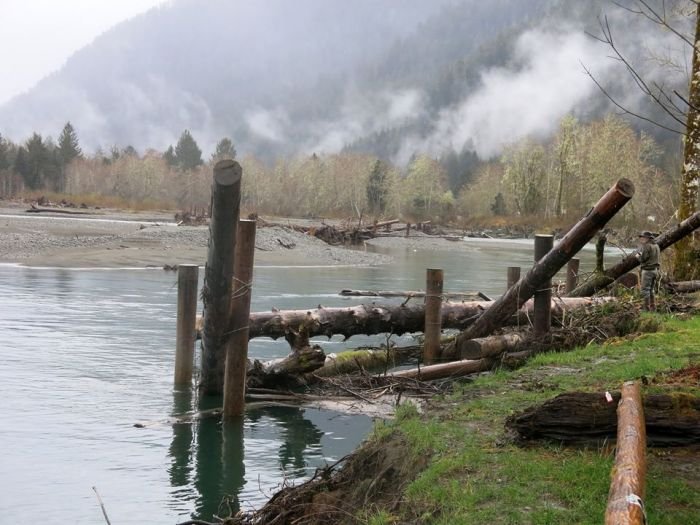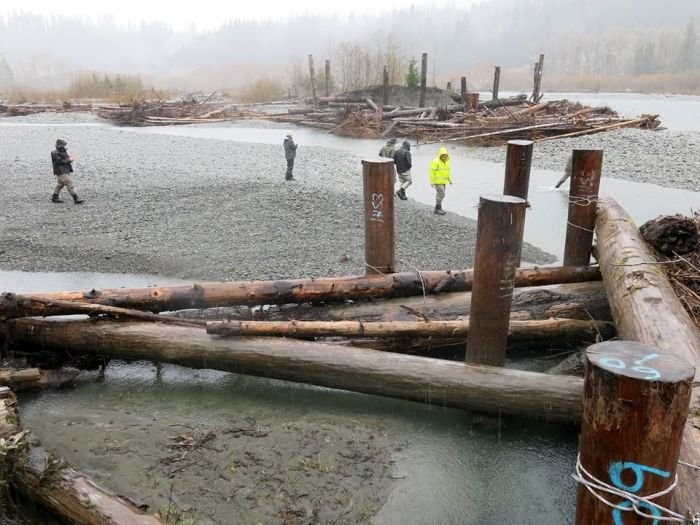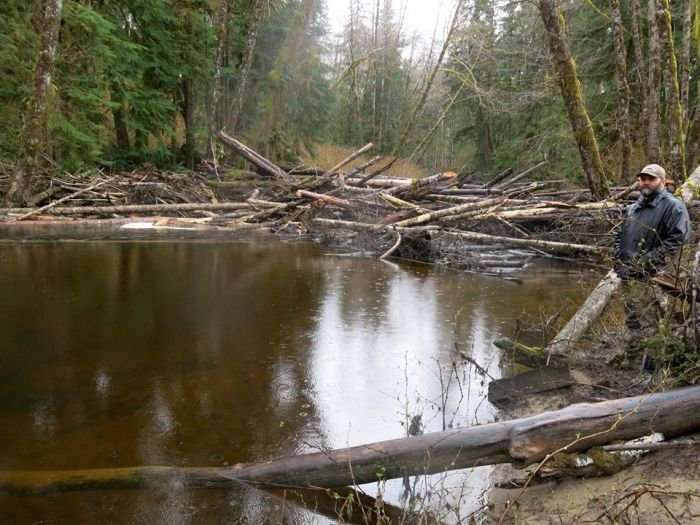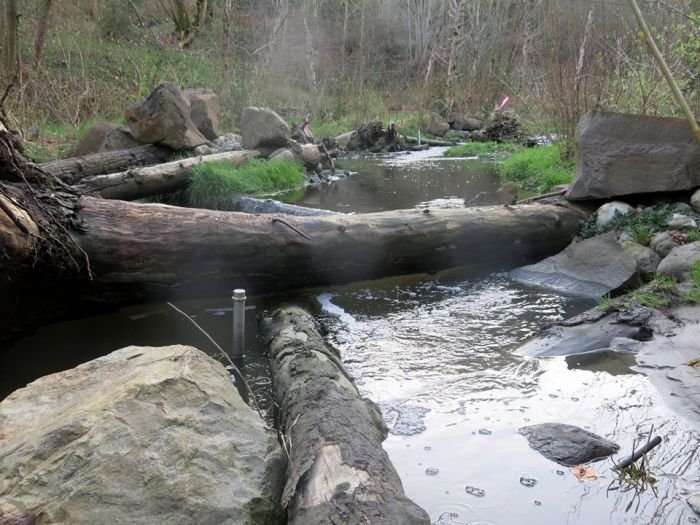What Can We Learn From Washington?
by Will Harling
This past spring, a contingent of fish habitat restorationists from around the Klamath River went up to Washington State to learn from four decades of salmon habitat restoration on the Olympic Peninsula and around the Puget Sound. We were hosted by Larry Lestelle from Biostream and Rocky Rocovich and Tim Abbe from Natural Systems Design, Inc. Bill Armstrong from the Quinault Tribal Fisheries Program and Mike McHenry from the Lower Elwha Tribal Fisheries Program added a lot to the first two days of the tour. So much learning took place that it's hard to capture, but we wanted to share through photos some of the amazing projects they have going and the lessons learned from them in this post. Partial funding for this tour came from the National Forest Foundation.
Our first stop on the Quinault River above Quinault Lake where the river was threatening a bunch of homes. A series of log jams and meander jams was pushing the huge river back across the floodplain to river right and making some great fish habitat at the same time.
An impressive array of engineered log jams on the Quinault River. These lathed log piers are driven 30-40 feet into the substrate to prevent pier scour. These streams on the peninsula were mostly glacially carved, with deep alluvium.
Larry Lestelle holding court, telling stories from the early days of coho life history construction, and subsequently coho habitat construction to meet specific life history needs. We have followed this model in the Klamath, first on Seiad Creek and the lower Klamath tribs like Hunter Creek, and now in Horse Creek, and the Scott Valley, with great success. But as Tim Abbe points out, this is not fixing stream process, just halting the trend towards extinction. We need to allow streams to reconnect to floodplains where they can so they can form habitats like this on their own. In the meantime, we'll keep building ponds.
Paradise Pond, one of the original off channel ponds constructed by Jeff Cederholm and Phil Peterson in the early ages of off channel pond construction 30+ years ago. What these guys hit upon was that it is habitat quality , and not quanitity, that depressed fish runs need to recover. If there is not off channel habitat in a stream system, juvenile coho have no where to go in high winter flows and they die. By sprinkling habitats like this throughout a system, you can rapidly reverse the trend toward extinction for coho salmon. This site keyed into a seep coming out of the mountain. They used dynamite to blast some deep holes out of the wetland then built a dam out of rock by hand to impound the water with a cheesy wood fish ladder. It was wildly successful but degraded quickly. Later the channel was re-contoured with an excavator with a meander to lower the gradient and increase fish access.
These jams still allow fish passage by having a tighter weave for the base and loose construction for the upper half. Logs are placed in an upstream facing chevron pattern that uses the stream force to lock them into place. Toz looks like he's getting some ideas for some streams back home.....
Bill Armstrong explains how the jams were constructed, while standing on three feet of new deposition on the recently connected floodplain.
Last year's high water scoured around the rootwad of this anchored wood, forming a sweet pool and bringing gravel into the channel from the banks.
Hurst Creek, a trib to the Clearwater on the west side of the Olympic Peninsula, was severely incised from a century of industrial logging. The creek itself was the original haul route, causing it to down-cut over 10 feet. Bill Armstrong told a chilling tale of three generations of loggers who told three different tales of this stream. The grandfather remembered it was full of salmon as a child but that the logging didn't kill the runs. The father remembers a few fish in the river that weren't affected by all the wood they removed to keep it from getting out of it's channel. The grandson doesn't remember seeing a fish in the creek. This aggressive wood loading project has reconnected the floodplain in only a couple years. Obviously not right for every stream, but already gravels are sorting, pools are forming, cover has increased many times over.... This is actually a picture looking upstream at three discrete channel spanning jams with 80-150 foot pools between them.
It can, and will, be done (just as they did here in the Elwha)! Klamath River 2020!!!!
Mike McHenry, a lifelong champion of fish habitat restoration on the Elwha, gave an amazing tour of his home river. So humbled by the quality of the tour and the knowledge of all the presenters.
I was not prepared for the incredible feeling of elation and gratitude and awe that came over me seeing a whole river system set free of dams after a century of plunder. The river is healing itself with incredible speed. Already five species of salmon have been found above this upper dam site. They estimate about 2/3rds of the sediment has gone downstream. During dam removal, they used an excavator on a barge with a jackhammer head to take it down slowly, then every now and again, they blew out a large chunk to make a pulse flow and create flood terraces upstream (visible in this picture).
Glorified rip rap with a high price tag. This structure near the end of the road heading up the Elwha (just downstream of the old Glines Canyon Dam site) protects the road but does little for fish habitat.
Toz Soto getting excited about dam removal!
Upper end of the old Elwha Dam reservoir. You can get an idea of the amount of natural wood in the system here.
Mitzi George Wickman giving scale to the stump of an old riparian Western Red Cedar at the upper extent of the Elwha Dam (RIP) reservoir. Extensive tree planting and invasive weed removal is ongoing in this newly exposed river channel.
A fish biologist that works with the Lower Elwha Tribe monitoring fish runs in the Elwha describes the fisheries benefits of these engineered log jams (ELJ's). They use horizontal projecting sonic cameras to count fish across a large channel just below this site.
This constriction caused by ELJ's (engineered log jam's) on either side of the channel were used frequently to push the river up onto the floodplain, as its doing here on river right. Cost for these structures is about $70,000 a piece. I came away thinking we need to spend about 10x our current annual restoration budget on the Klamath to actually restore the river processes they are restoring on these rivers.
Beaver lodge built into the side of a log jam on the Elwha River about five miles up from the estuary.
Clear Creek on the east side of the Olympic Peninsula was an example of a fish habitat restoration project that also solved a transportation issue. Every year a major street just downstream would flood due to poor water storage and drainage. By reconnecting the floodplain and establishing multiple channels, NSD has kept the road from flooding for the past three years.
Sediment from the Elwha dam removal effort not only restored the delta at the mouth, it also reconnected far reaching backwater areas in the larger floodplain that hadn't been connected in decades. This is paradise for rearing juveniles preparing to head out into the ocean.
After two days exploring the wild rivers of the Olympic Peninsula, we took the ferry across to Seattle and civilization. Before you die, go to Ray's Boat House restaurant. I did an animated retelling of Uncle Billy's Bigfoot Hunting mishap story so the Washingtonians got a taste of who they were dealing with.... — with Sarah Bee, Rocco Fiori and Charles Wickman.
Historically the main channel flowed on the right side of the South Fork Nooksack behind that large log jam where a slack water pool has now formed. The log jam on the left has racked a bunch of wood and subsequently a bunch of spawning gravel upstream that has become a hotspot for spawning salmon. This section of the channel has aggraded over seven feet in four years and connected a two-mile-long side channel or river right above the large log jam.
Tim Abbe describes how the log trianges are stabilized by boulder and cable "dingleberries" (two boulders with glued in cable connecting them over top of the logs to keep them hinged on pounded log piers. Charlesand Mitzi are standing on top of a buried boulder and you can see the cable insertion behind Tim's feet.
All for one, one for all! Charles Wickman gets a lift from Toz Soto and Larry Lestelle with help from Rocco Fiori and Tim Abbe across a side channel of the SF Nooksack! Mitzi just walked across in her Levis.....
Joey Howard from Cascade Stream Solutions, Rocky Rocovich with Natural Systems Design and Rocco Fiori with Fiori GeoSciences, have an engineers huddle at an impressive channel spanning wood structure on the SF Nooksack. Two engineered log jams on either side are connected by grade controlling log triangles (underwater in this pic) stabilized by boulders with cable saddling the logs and short log piers to hold them in place. In a very short amount of time (less than five years) these structures have aggraded this downcutting section and reconnected a huge floodplain. These structures have possible application in the Klamath mainstem above Happy Camp and in the Salmon River in unconstrained channel reaches.
Toz Soto, Tim Abbe, Nooksack Tribal Fish Biologist, Rocky Rocovich, and Mitzi Wickman on a pile jam on the South Fork Nooksack River. The weather was crappy the whole time but we were electric with inspired fish talk. These jams rack mobile wood, and cost a lot less than jams that use off site wood. This was the jam that was causing the side channel that Mitzi log tight roped across.
South Fork Nooksack River showing the difference between rip rap (left) and large wood meander jam (right). We are currently facing issues with Siskiyou County Public Works Department with our Seiad Creek stream restoration project because they believe wood bank stabilization projects will rot and fail. The wood gives a chance for trees to grow and becomes the bank stabilization agent. Hopefully these projects will help inform our efforts down here to restore streams that function for fish as well as people.
South Fork Nooksack River: Mitzi Wickman uses a beaver felled log to cross a new floodplain braid caused by an engineered log jam upstream that activated a 40 acre floodplain. The beavers were going crazy!
South Fork Nooksack River showing the use of large wood instead of rock rip rap for bank stabilization. It's hard to see in this picture, but the logs are extended out into the river to provide instream cover.
Urban stream renewal at work. Everything in this stream is constructed after contaminated dirt was removed. The off channel pond on creek right is fed by hyporheic flow through strategically placed gravels.
Example of a meander jam on an urban stream (Thornton Creek) just north of Seattle on a system impacted by the first (if not the largest) mall in America (Northgate Mall). Logs were placed at variable depths and prowed out over the water to create instream cover. The largest fish of the tour, what I took as a steelhead was spotted testing a redd just downstream.
Small urban stream restoration further up Thornton Creek after a 10,000 gallon petroleum spill upstream (below the mall....). This was a high dollar project meant to monitor the ability of deep gravel lenses inoculated with beneficial algae to treat contaminated water over time. Extensive monitoring showed water quality at variable depths. They had created these gravel cylinders that could be pulled out of tubes to provide consistent samples of macroinvertebrate populations. Log pour-overs were co-located with gravel to force the water subsurface where more cleaning could take place. Larry Lestelle grew up fishing this creek before it got trashed. I found a kid size fishing bobber in an eddy....the magic is happening again! These projects may not have the hugest effect on the fishery, but they bring restoration to the masses, and they are beloved by nearby residents and schools.
Will Harling serves as Director of the Mid Klamath Watershed Council. Born and raised in the Middle Klamath, Will brings a lifetime of local knowledge and a love for this place to the work of watershed restoration.





























